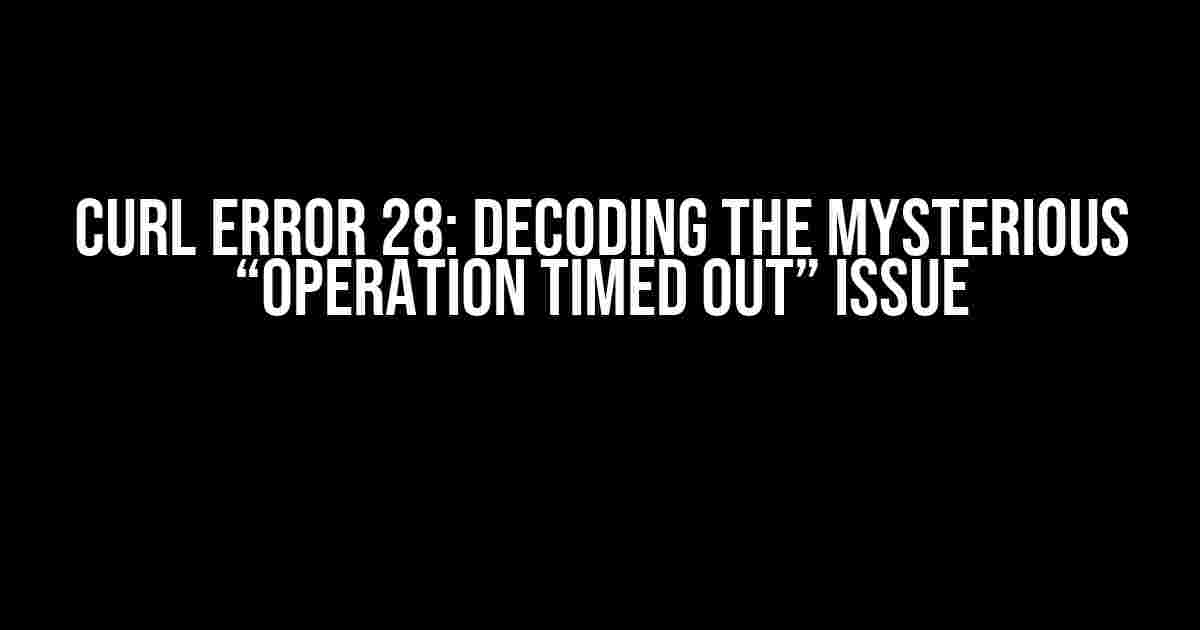If you’re reading this, chances are you’ve encountered the frustrating cURL error 28, which cryptically states: “Operation timed out after 30004 milliseconds with 0 bytes received”. Don’t worry, you’re not alone! In this article, we’ll delve into the world of cURL, explore the possible causes of this error, and provide you with a step-by-step guide to troubleshoot and resolve the issue.
What is cURL and why does it matter?
cURL (Curl URL) is a command-line tool for transferring data to and from a web server using HTTP, HTTPS, SCP, SFTP, TFTP, and more. It’s an essential tool for developers, system administrators, and anyone who needs to interact with web services. cURL is widely used for tasks like fetching web pages, downloading files, and sending requests to APIs.
So, why does cURL matter? Well, without cURL, many of the online services we rely on wouldn’t function. Imagine a world without social media, online banking, or e-commerce – that’s the kind of impact cURL has on our digital lives.
What causes cURL error 28?
cURL error 28 can occur due to various reasons. Let’s break them down into categories:
-
Network Issues
- Slow or unstable internet connection
- Firewalls or proxies blocking the request
- DNS resolution issues
-
cURL Configuration
- Incorrect or outdated cURL version
- Misconfigured cURL options (e.g., timeout, connect-timeout)
- Insufficient buffer size
-
Server-Side Issues
- Server overload or high latency
- Server-side firewall or rate limiting
- Resource constraints (e.g., CPU, memory)
-
Environmental Factors
- System resource limitations (e.g., CPU, memory)
- File system issues or permissions problems
- Resource-intensive processes running concurrently
How to troubleshoot cURL error 28?
To troubleshoot the issue, follow these steps:
-
Verify your internet connection
Check your internet connection speed and stability using tools like
speedtest.netorpingcommands. -
Review cURL configuration and options
Check your cURL version using
curl -V. Ensure you’re using the latest version and correct configuration options.curl -V curl --connect-timeout 300 --max-time 300 https://example.com -
Investigate server-side issues
Use tools like
ping,dig, orwgetto test server availability and response times.ping example.com dig example.com wget -q -O /dev/null https://example.com -
Check system resource utilization
Monitor system resource usage (CPU, memory, disk) using tools like
top,htop, orsystem monitor. -
Verify file system permissions and availability
Check file system permissions and availability using commands like
ls,df, andmount.
How to resolve cURL error 28?
Based on your troubleshooting results, try the following solutions:
| Cause | Solution |
|---|---|
| Network Issues |
|
| cURL Configuration |
|
| Server-Side Issues |
|
| Environmental Factors |
|
Conclusion
cURL error 28 can be frustrating, but by following this guide, you should be able to identify and resolve the underlying issue. Remember to work methodically, eliminating potential causes one by one. If you’re still stuck, don’t hesitate to seek help from online communities or experts.
As you navigate the world of cURL, keep in mind that patience, persistence, and practice are key to mastering this powerful tool. Happy troubleshooting!
Frequently Asked Question
If you’re struggling with cURL errors, you’re not alone! Here are some frequently asked questions to help you troubleshoot and resolve the dreaded “cURL error 28: Operation timed out after 30004 milliseconds with 0 bytes received”.
What does the “cURL error 28” mean?
The “cURL error 28” means that the server didn’t respond within the allotted time (in this case, 30 seconds). It’s like waiting for a friend who never shows up – frustrating and unproductive! This error usually occurs when the server is slow, busy, or experiencing high traffic.
Why does cURL timeout after 30004 milliseconds?
The timeout value of 30004 milliseconds (or 30 seconds) is a default setting in cURL. It’s like a timer that says, “Hey, I’ve waited long enough! Time to move on!” You can adjust this value according to your needs, but be careful not to set it too high or you might end up waiting forever!
How can I increase the cURL timeout value?
You can increase the timeout value by using the `–max-time` or `-m` option followed by the desired time in seconds. For example, `curl -m 60 https://example.com` will set the timeout to 1 minute. Just remember, a longer timeout doesn’t always mean a solution – it might just mean you’ll wait longer for nothing!
What should I do if I’m getting cURL error 28 frequently?
If you’re getting this error frequently, it might be a sign of a deeper issue. Check your server’s performance, optimize your code, and consider implementing retries or caching mechanisms. You can also try using alternative libraries or tools that handle timeouts more efficiently. Don’t let cURL errors hold you back – troubleshoot, adapt, and overcome!
Is there a way to retry cURL requests on timeout?
Yes, you can use the `–retry` or `-R` option followed by the number of retries and the delay between retries in seconds. For example, `curl -R 3 -retry-delay 10 https://example.com` will retry the request up to 3 times with a 10-second delay between retries. This way, you can give the server another chance to respond without giving up too quickly!
